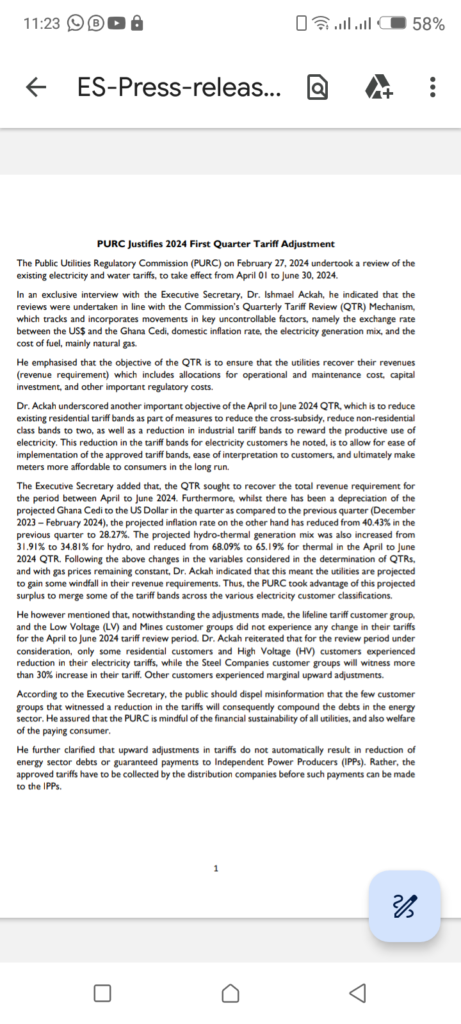adverts
The Public Utilities Regulatory Commission (PURC) has explained the rationale behind the tariff review for the first quarter of 2024.
On February 28, the commission announced a minor decrease in electricity tariffs for residential consumers, while maintaining the current rates for lifeline consumers (0-30 kWh) and residential consumers using 0-300 kWh.
PURC highlighted that the slight tariff reduction of 6.56% would be advantageous to residential consumers using more than 301 kWh.
adverts
In a statement released on March 5, the PURC revealed that it conducted a review of the existing electricity and water tariffs on February 27, 2024. The revised tariffs will be effective from April 01 to June 30, 2024.
Dr Ishmael Ackah, the Executive Secretary of the PURC, emphasized that the reviews were conducted in accordance with the Commission’s Quarterly Tariff Review (QTR) Mechanism. This mechanism monitors and incorporates changes in key uncontrollable factors such as the US$ to Ghana Cedi exchange rate, domestic inflation rate, the electricity generation mix, and fuel costs, primarily natural gas.
Dr Ackah stressed that the QTR aims to ensure utilities recover their revenues, which includes allocations for operational and maintenance costs, capital investment, and other significant regulatory costs.
Another key objective of the QTR for April to June 2024 is to decrease existing residential tariff bands to reduce cross-subsidy, reduce non-residential class bands to two, and lower industrial tariff bands to encourage productive electricity use.
Dr Ackah noted that these tariff band reductions would simplify the implementation and interpretation of approved tariff bands, and ultimately make meters more affordable for consumers.
He added that the QTR aims to recover the total revenue requirement for the period from April to June 2024. Despite the depreciation of the projected Ghana Cedi to the US Dollar in the quarter compared to the previous one (December 2023 – February 2024), the projected inflation rate has decreased from 40.43% to 28.27%.
The projected hydro-thermal generation mix was adjusted from 31.91% to 34.81% for hydro, and from 68.09% to 65.19% for thermal in the QTR for April to June 2024.
Dr Ackah indicated that these changes, along with constant gas prices, mean that utilities are projected to see a windfall in their revenue requirements. As a result, the PURC used this projected surplus to consolidate some of the tariff bands across various electricity customer classifications.
However, he said that despite these adjustments, the lifeline tariff customer group, and the Low Voltage (LV) and Mines customer groups did not see any changes in their tariffs for the April to June 2024 tariff review period.
Dr Ackah reiterated that only some residential customers and High Voltage (HV) customers saw a reduction in their electricity tariffs for the review period, while the Steel Companies customer groups will see more than a 30% increase in their tariff. Other customers experienced slight upward adjustments.
He urged the public to disregard misinformation that the tariff reductions for a few customer groups will exacerbate the debts in the energy sector. He assured that the PURC is mindful of the financial sustainability of all utilities, as well as the welfare of the paying consumer.
He further clarified that upward adjustments in tariffs do not automatically result in reduction of energy sector debts or guaranteed payments to Independent Power Producers (IPPs).
Rather, the approved tariffs have to be collected by the distribution companies before such payments can be made to the IPPs.
Read below full statement from PURC on the Tariff Adjustment:



